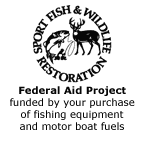System design
Think your system design through carefully and lay out piping and other system components before cutting anything. Check on each side of partitions or bulkheads to be sure you will not be cutting into fuel of water tanks, wiring or piping, or into stringers that support the hull. If you must cut tabbing that holds bulkheads or partitions in place, provide additional reinforcement so that structural integrity is not compromised.
To reduce likelihood of odor permeation, consider what will be "wet" (sewage filled) between pumpouts. Work toward reducing wet sections of piping. When wet sections are unavoidable, consider rigid PVC pipe rather than hose. Keep the number of connections to the minimum. Try to eliminate tight bends; use "sweeps" to minimize clogging. Provide for easy access to system fittings, connections, and components for maintenance.
Toilets
- Install per manufacture's directions.
- Electrical wiring (if any) should comply with ABYC standards E-8, AC Electrical Systems in Boats, and E-9, DC Electrical Systems Under 50 Volts.
- Freshwater hookups must comply with ABYC standard H-23, Installation of Portable Water Systems, which requires physical separation of drinking water from the sewage system.
Holding tanks
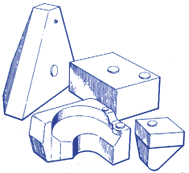
- Examine the area where the tank is to be located. Ensure the tank will not be punctured by sharp objects, such as protruding screws.
- Since sewage weighs approximately eight pounds pre gallon, the contents of a 15 gallon waste tank can weigh up to 135 pounds. Tank supports and restraints must be adequate to hold the tank in place even under extreme operating conditions. Multiply the tank and the weight of its contents when full by a safety factor of two when estimating the total weight to be restrained. Here's the formula:
(Weight of the tank alone) + (Volume in gallons x 8 lbs.) x (Safety factor of 2)=Total weight to be restrained.
- Plywood floors, bracing, chocks, straps, etc. may need to be reinforced to perform as required. Visualize the tank restraint system with your boat operating at full speed pounding into waves (or running suddenly aground).
- To minimize the potential for chafe and corrosion, a nonabsorbent, nonabrasive material such as neoprene should be used between all tank supports, bracing, etc. and the tank itself. This is a must for all metal tanks.
- Ideally, inlet and outlet fittings should be at or near the top of the tank. This arrangement will facilitate repairs when needed, enable hoses to be self-draining and minimize permeation. If inlet and outlet fittings are installed at or near the bottom of the tank, hose permeation will occur more rapidly. Install a valve at the tank outlet to permit servicing of the discharge line without spilling sewage.
- If the discharge is located at or near the bottom of the tank, a rigid P-trap below outlet level in the outlet piping will allow the tank to be completely emptied. A dip tube will be required for top mounted discharge fittings.
- Vent line fittings must be located at the uppermost point of the top surface of the tank if they are to operate effectively.
- When installing fittings in polyethylene tanks, follow the tank manufactures directions. The tank can be damaged by over tightening fittings at connection points. This type of damage may not be detected when making the connections, but will manifest itself later in leaks and cracks.
- Most polyethylene tanks have inspection ports (typically 3" in diameter). While there is an increased possibility of leaks and odors if ports are not installed, a properly gasketed inspection port should reduce the likelihood of a problem. Inspection ports can be used can be used to access the tank for cleaning. They also facilitate installation of a sewage level indicator.
- Install flexible tanks per manufacture's directions. Bladder tanks used for holding sewage must have a vent line so that gasses produced by decomposing sewage can escape.
- Construct FRP tanks per resin manufacture's recommendations.
Deck fittings
- Once you have determined the location of the deck pumpout fitting, drill a pilot hole through the deck from inside the boat to avoid hitting interior wiring, etc.
- Remove core material (if any) around mounting hole; fill the resulting void with fiberglass filler.
- Bed deck fitting thoroughly to avoid water leakage to interior.
- Bolt the fitting through the deck. A screwed fitting can come loose from repeated forces of connecting the deck fitting with the pumpout facility nozzle or adapter.
Piping/hose
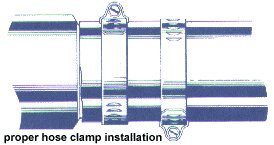
- To minimize the likelihood of permeation and odors, keep hose runs as short and straight as possible. Avoid dips in the hose run which remain "wet". Whenever practical, use rigid pipe below the level of the top of the holding tank since sewage will sit in this piping whenever the tank in full ("wet" hose will permeate more quickly). Use sweeps instead of elbows in connections whenever possible.
- Ensure that the holding tank vent line has a constant rise from the top of the tank to the vent fitting. Otherwise low spots may fill with sewage and act as a "U" trap, effectively plugging the vent. Vent line should be as short as possible.
- Heating the end of the hose and coating the pipe fittings with liquid soap as a lubricant will make fitting sections easier. Hot water, and electric hair dryer or heat gun can be used to soften the hose.
- Use cable ties or clamps to support piping along its entire run against movement laterally as well as vertically. This will help minimize the likelihood of loosening connections during stress of boat operation, flexing, vibration or impact from gear stowed alongside. Visualize how a hose or pipe full of liquid might move under normal operating conditions (in response to vibration, wave action, heeling, etc.)
- Provide chafe protection where hose is run through bulkheads and at all support brackets of ties.
Fittings
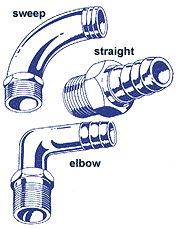
- All waste system connections and fittings should be capable of being reached for inspection, removal or maintenance without removal of permanent boat structure.
- Before cementing a length of PVC pipe to a fitting, use a solvent cleaner on the pipe and inside the fitting before coating them with PVC cement. Immediately press the pipe home, twisting a half a turn or so to spread the cement evenly. Hold the joint for about 30 seconds to give the cement a chance to set up; do not subject it to pressure for at least a half hour.
Sealants
- If a sealant is used when fitting a hose, it should be applied to the outer surface of the adapter. Do not apply sealant to the inside of the hose; it will only be pushed farther inside the adapter, where it will solidify and cause blockage.
Clamps
- Do not overtighten clamps or they may cut into the hose. If this is the only way to stop a leak, the hose-to-adapter fit is not good enough, and one or the other should be changed. The use of two clamps at each connection (where space allows) will keep the hose in line with the adapter and lessen the likelihood of leaks.
- Make sure the clamp mechanisms are offset from each other when tight.
Vent fittings
- The holding tank vent fitting should be located above the holding tank and above the waterline at all angles of heel. It should also be no less than 24 inches away from any opening into an accommodation space.
- If fitting is to be located in hull topsides, select a protected spot where it will not be subject to damage from pilings, etc.
- Form a gooseneck in the vent line above the vent fitting to prevent seawater from back flooding to the tank. This also may keep the vent line from kinking.
- Bed fitting to avoid water leakage into interior of boat.
Vent line filters
- Install per manufacture's recommendations.
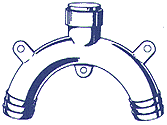
Siphon breaks
- A vented loop in the discharge line can allow foul odors into the boat. Run a small hose from the siphon break vent fitting to the holding tank vent line or to a separate vent fitting located above the maximum heeled waterline.
Pumps
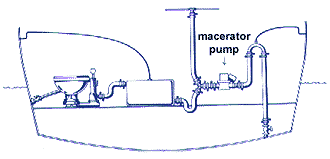
- Consider pump manufactures' requirements (if any) for discharge line and run.
- Diaphragm pumps should be mounted above the level of the top of the holding tank so that they will not be sewage filled when the tank is full. This will minimize permeation of the flexible diaphragm material.
- Electrical wiring (if any) should comply with ABYC standards E-8,AC Electrical Systems in Boats, and E-9, DC Electrical Systems Under 50 Volts.
- If pump is not installed above the tank level, service valves should be provided to enable pump removal without releasing tank contents.
Sewage treatment equipment (Type I, II MSDs)
- Install per manufactures' directions.
- Electrical wiring (if any) should comply with ABYC standards.
- Maintenance per manufacturer's instructions is essential to guard against malfunction and ensure sewage treatment in accordance with federal law.
Note: Test a newly installed system using colored water and softfood solids (overripe bananas work well) under normal boat operating conditions to be sure there are no leaks. Inspect entire system regularly for evidence of leaks.

